

02/2005
by Heather Livingston and Russell Boniface
Component leaders joined forces on February 10 to take issues important to architects, and consequently the rest of the U.S. citizenry, to their representatives in the 109th Congress. AIA members have repeatedly identified government advocacy as critical to the profession, a key reason for becoming (and remaining) an AIA member, and an effort that should be conducted year-round. Following presentations from Representatives Michael Turner (R-Ohio), Earl Blumenauer (D-Ore.), and an advocacy panel composed of lobbyists and policy-watchers, AIA component leaders headed to Capitol Hill to bring their messages to their states’ legislators. Members of the AIA national component staff tagged along with the AIA Houston and AIA Oregon delegations to bring you this report.
Setting the agenda
On the evening of February 9, Tom Wolfe, AIA senior director of
federal affairs, outlined the specifics of the AIA’s legislative
agenda. Grassroots participants were given four “asks” to
take to the Hill, three of which were targeted and one universal. The
universal ask was cosponsorship of the Portman-Jefferson
Affordable Housing/Historic Preservation/Community Revitalization bill.
The AIA supports the bill, which updates the federal tax credit for
rehabilitation of historic buildings. Portman-Jefferson would expand
the credit for residential rental housing, allow the credit to be used
in tandem with the low-income tax credit, and increase the amount of
the credit in difficult-to-redevelop areas. The bill was introduced
late in the 108th Congress, and no committee action was taken. Grassroots
leaders asked their members of Congress to sign on as cosponsors and
their senators to sponsor a counterpart bill.
Three targeted “asks” were assigned based on the legislators’ roles in Congress and the specifics of their localities:
- The Brownfields Redevelopment Initiative would create an environmental remediation tax credit for the clean-up of contaminated sites in disadvantaged neighborhoods
- The AIA’s energy initiative would task GSA with establishing a photovoltaic energy commercialization program to procure and install solar electric systems in new and existing federal buildings
- The Community Enhancement/Transportation Initiative would add funds to the soon-to-be-debated highway bill to study the impact of transportation construction on neighboring communities, and recommend ways of encouraging thoughtful design that builds community rather than disenfranchises residents and businesses.
AIA Government Advocacy Vice President Ron Faucheux, Esq., PhD, said, “Your job tomorrow is to be a good citizen, a good architect, and fight to make the world a better place.”
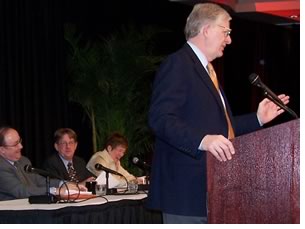 Advice from the panel
Advice from the panel
Before heading to Capitol Hill on February 10, the component troops were
greeted by a panel featuring James A. Thurber, founder and director
of the Center for Congressional and Presidential Studies at American
University; Mike Evans, partner with the prominent law firm Preston,
Gates, Ellis & Rouvelas
Meeds, LLP, and former chief counsel and deputy staff director of the
Senate Finance Committee; and Steven E. Billet, chief of staff and
director of external affairs for the Graduate School of Political Management
at George Washington University and director of GW’s PAC Management
Certificate Program.
Lobbying strategies: Thurber, commenting on the strength of the AIA delegation descending on the Hill, offered praise. “Advocating for what you believe in is our democratic right. It’s freedom of speech at its best. It’s absolutely wonderful.” Offering a Washington-insider perspective to the Grassroots attendees, Thurber said, “What you need to know about this Congress is that it’s increasingly bi-modal. There are very few representatives in the middle now. Partisanship is becoming vicious and the minority party is cut out of the action these days.”
Thurber’s also offered keys to a successful lobbying strategy:
- Mobilize at the grassroots level
- Build a coalition of support
- Frame the issue using advertising and public relations
- Conduct research, including policy, political, and legal analysis
- Get involved in national and local campaigns through volunteer efforts and funding
- Conduct direct lobbying.
“A view from the shop floor:” Evans, a self-described “Hill rat,” offered the AIA leaders “a view from the shop floor.” First, he said, the House and Senate are very different in fundamentals, which means they operate differently. While they work cooperatively at the top tiers, the lower levels function independently, with most work getting done in committee. In the Senate, the floor debate is where issues are hammered out. “Members of Congress have a relatively predictable outlook,” he continued. “It will be determined by their constituency, the representative’s congressional role, and her individual interests.”
In conclusion, Evans noted three points to remember about the political process in Congress.
- The system is complex—between the Senate, House, and various committees—and to lobby effectively you need a range of experts and skills taking a team approach on issues.
- You have to be flexible. Think about how your agenda fits in with your representative’s agenda and his or her role. Be flexible with your arguments and adapt to take advantage of upcoming issues.
- The grassroots effort is very important; effective advocacy requires a good grassroots campaign. As an example, he noted that when the 2004 JOBS bill was pending, Texas Society of Architects Executive Vice President David Lancaster’s meeting with Senator Kay Bailey Hutchinson (R-Tex.) was critical—that visit made all the difference to ensuring that A/E services were included in the bill.
The importance of being earnest (about PACs): Billet congratulated the AIA and component leadership for putting together a conference the size and scale of Grassroots, noting that “you all are already committed” to the AIA’s issue agenda. He then said that the task ahead is to convince the other 74,000 members of its importance. AIA’s PAC isn’t bad he noted, but it could be great, “You need to talk to your colleagues and build a network. Your PACs could really deliver, on both the state and federal level.”
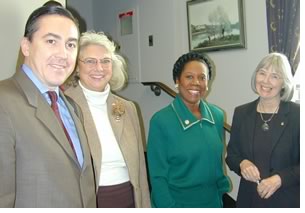 With the Houston delegation on the Hill
With the Houston delegation on the Hill
The cold and blustery morning did not deter the Houston AIA delegation,
whose members each shared a happy confidence as they approached the
Rayburn Congressional Office Building on their way to visit their Texas
representatives. Braving the winds of Washington were Randall Walker,
AIA, president; Jeffrey Brown, AIA, president-elect; Barrie Scardino,
executive director; Martha Seng, AIA, past president; Martha Murphree,
Hon. AIA, consultant and former executive director; and Steve Parshall,
FAIA, vice chair, Center for Building Performance.
President-Elect Brown stated the team’s goals underscored those of the AIA regarding getting cosponsorship for the Portman-Jefferson Act. “We have one universal song, which is our support for revisiting the now 20-year-old federal tax credits for affordable housing, community revitalization, and historic preservation.”
Members of AIA Houston had a full slate of meetings, including appointments with the following congressmen: House Majority Leader Tom DeLay (R-Tex., 22nd); Sheila Jackson Lee (D-Tex., 18th); Gene Green (D-Tex., 29th); Kevin P. Brady (R-Tex., 8th); Al Green (D-Tex., 9th); Ted Poe (R-Tex., 2nd); and John A. Culberson (R-Tex., 7th).
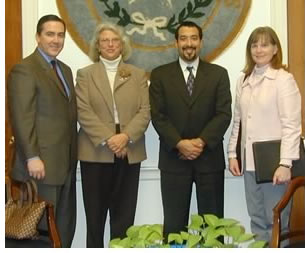 The team was very pleased with the outcome of all their meetings. The
first meeting, which was with Rep. Jackson Lee, set a positive tone for
the day. “I think we connected very well with her, both her agenda
and our agenda,” said Parshall. “I think we are off to a
good start.”
The team was very pleased with the outcome of all their meetings. The
first meeting, which was with Rep. Jackson Lee, set a positive tone for
the day. “I think we connected very well with her, both her agenda
and our agenda,” said Parshall. “I think we are off to a
good start.”
Scardino described the meeting with Jackson Lee as “wonderful” and was “happy to have met her and impressed with her knowledge of House strategies.”
The determined Houston team split up to cover more ground and was welcomed at each Lone Star stop. All the representatives and their aides were very interested in the Houston team’s presentation and engaged them in meaningful dialogue. In the end, President-Elect Brown believed all the meetings went very well. “They universally admired us and our goals. There was no chin-wagging. They were all well informed.” He also complimented the AIA for providing detailed literature about affordable housing, community revitalization, and historic preservation. “The issues were clearly outlined by the AIA packages, and this was a great help.” Brown also mentioned he was impressed with Tammy Fisher, legislative assistant for Congressman Brady, and Leo Munoz, legislative assistant to Congressman Green.
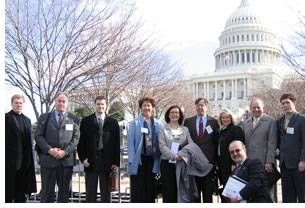 Oregon delegation presents priorities
Oregon delegation presents priorities
The poised and pensive delegation from AIA Oregon, along with AIA Senior
Director of Federal Affairs Wolfe, together tackled the morning’s
first appointment with Senator Ron Wyden (D-Ore.) in the historic Dirksen
Senate Office Building. Advocates from Oregon included Saundra Stevens,
Hon. AIA, executive vice-president, AIA Oregon/AIA Portland; Stuart
Weir, assistant director, AIA Oregon; Stan Chessir, AIA, president,
AIA Portland; Jonathan Stafford, AIA, president, AIA Oregon; Scott
Stolarczyk, AIA, president, AIA Southwest Oregon; Nancy Merryman, AIA,
president-elect, AIA Portland; Dana Ing, Assoc. AIA, associate director,
AIA Oregon; Mark McKechnie, AIA, president-elect, AIA Southern Oregon,
and John Weekes, AIA.
Members of the group spoke about the need for a Senate sponsor for both the Portman-Jefferson and Community Enhancement Transportation bills with Legislative Aide Elaine Paulionis. In addition to the key AIA advocacy issues, the group also discussed the impact of the community development block grants that are on the chopping block in the 2006 federal budget. “We have a program that really works—that has proven results,” said Stafford. “These cuts will affect every community throughout the United States. They provide ancillary benefits that are hard to measure, but that benefit the sense of community. I’m surprised that every single mayor in the country isn’t calling their representatives to protest the cuts.”
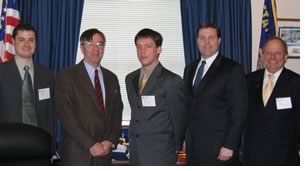 Following the meeting with Sen. Wyden’s aide, the Oregon contingent
split up to deliver their messages to Congressmen David Wu (D-Ore., 1st),
Greg Walden (R-Ore., 2nd), Earl Blumenauer (D-Ore., 3rd), Darlene Hooley
(D-Ore., 5th), Peter DeFazio (D-Ore., 4th), and Senator Gordon Smith
(R-Ore.). During the visit to Congressman Walden’s office, Brian
Hard, legislative director for the congressman, praised the component’s
efforts and organization, “Most groups that come in here can’t
answer the question, ‘What does this mean to Oregon?’ Your
materials show exactly where architecture and construction professional
services fit into the local economy. I will share this information with
the congressman for sure.”
Following the meeting with Sen. Wyden’s aide, the Oregon contingent
split up to deliver their messages to Congressmen David Wu (D-Ore., 1st),
Greg Walden (R-Ore., 2nd), Earl Blumenauer (D-Ore., 3rd), Darlene Hooley
(D-Ore., 5th), Peter DeFazio (D-Ore., 4th), and Senator Gordon Smith
(R-Ore.). During the visit to Congressman Walden’s office, Brian
Hard, legislative director for the congressman, praised the component’s
efforts and organization, “Most groups that come in here can’t
answer the question, ‘What does this mean to Oregon?’ Your
materials show exactly where architecture and construction professional
services fit into the local economy. I will share this information with
the congressman for sure.”
The group’s last visit with Rep. Blumenauer’s Legislative Director James Koski and aide C.J. Laffer echoed through the halls of Congress—literally. Due to the tight spaces in the Rayburn, the group gathered in the hallway outside the congressman’s office. With the Washington Monument framed in the window beyond, the delegation asked for support on the energy/photovoltaics bill as well as Portman-Jefferson. Understanding the importance of knowing their legislators’ personal agendas, the group offered their support and technical assistance on Blumenauer’s brownfields clean-up initiative, which focuses particularly on abandoned military bases and sites in the downtown core. Although they received no firm commitment from Koski on either bill, he said that the congressman would give the issues serious consideration. Referencing Blumenauer’s presentation to Grassroots attendees the evening before Advocacy Day, Koski praised the AIA’s thoroughness and renewed dedication to government advocacy, “Earl sees the difference, and he felt the difference yesterday. We certainly appreciate this.”
When asked about the results of Advocacy Day, AIA’s Wolfe responded, “It’s a bit early to have real results . . . I think the best news is the almost universal upbeat reactions that AIA members came back from the Hill with . . . Grassroots visits aren't the end of the process—just the beginning.”
Copyright 2005 The American Institute of Architects.
All rights reserved. Home Page ![]()
![]()
 |
||
For
more information, visit Government Advocacy on the AIA Web site.
|
||